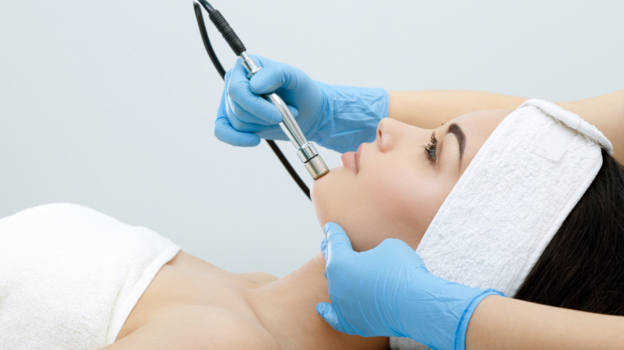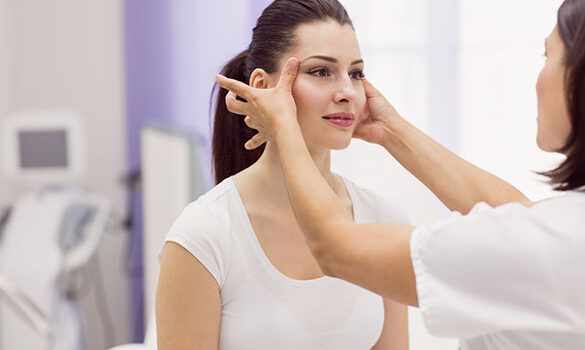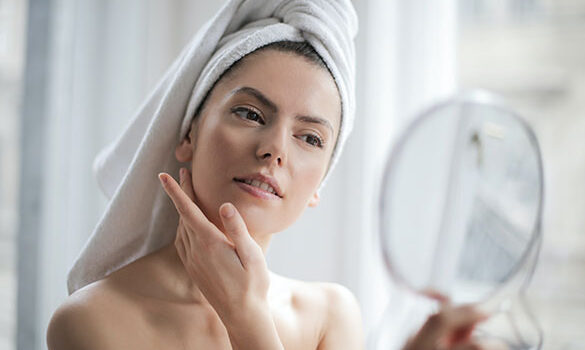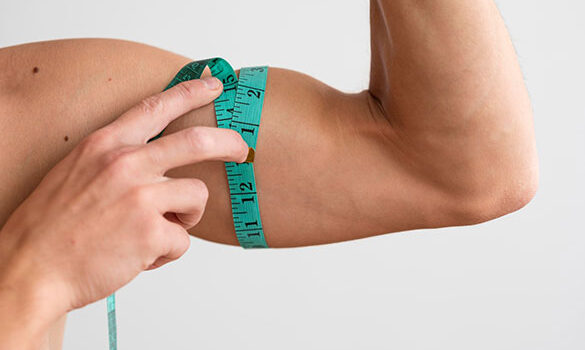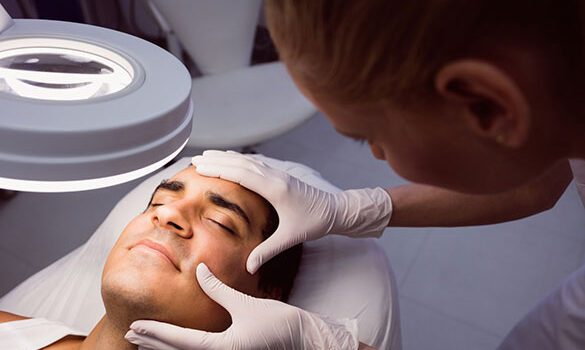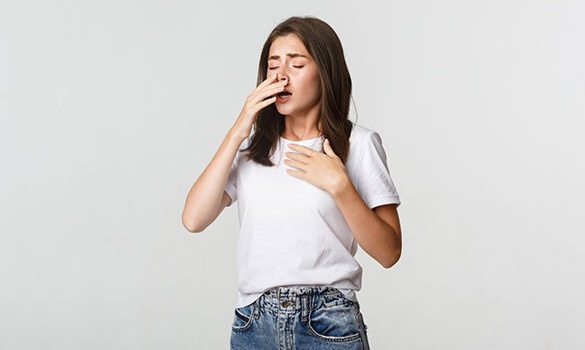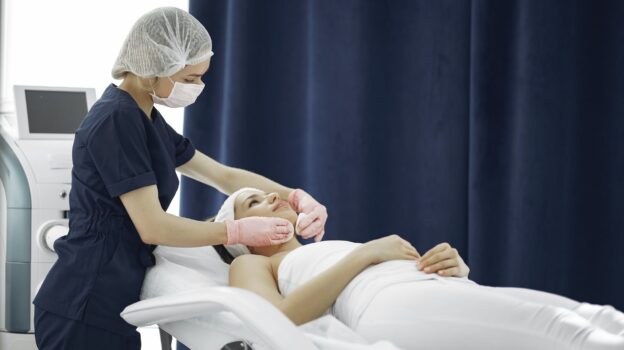Sun spots are flat brown spots that appear on skin areas that are frequently exposed to sunlight. They are also referred to as age spots or liver spots and commonly occur in people over the age of 40. However, sun spots can also develop on the skin of younger individuals who spend a significant amount of time in the sun without taking measures to protect their skin.
Although sun spots on the skin are typically harmless, many people want to get rid of them for cosmetic purposes to improve their self-esteem. GraceMed medical spas offer services that play a significant role in removing sun spots and helping patients achieve younger-looking skin.
If you want to learn how to get rid of sun spots, it’s essential to understand what do sun spots look like and why they appear. More information will enable you to make educated decisions about the type of treatments to seek when you want to remove sun spots.
What Are Sun Spots?
Sun spots are little areas of hyperpigmentation which occur when melanocytes in the skin produce more pigment in a small, concentrated area. Although these spots are harmless, it can be helpful to treat them in their early stages as this allows you to ensure that the sun spots aren’t a sign of any other skin condition, such as melanoma. This will allow you to differentiate between different skin conditions.
Melanoma is the fastest-growing form of skin cancer, so treating any type of spot at the earliest possible is essential. Sun spots crop up in areas of the skin due to sun exposure, whereas melanoma can appear anywhere, even in areas with limited sun exposure. The best way to identify sun spots or other conditions is by consulting a skin specialist. book a consultation at our Oakville Inglehart location. You can also connect with a GraceMed dermatologist in Mississauga or other cities in the GTA to explore other treatment options.
Causes of Sun Spots
You may notice white spots on skin from sun exposure, but it’s essential to understand if sunlight is the leading cause of the skin condition. Although sun damage spots are the most common condition that most aging adults witness, there could be other causes of sun spots. Other factors contributing to sun spots on the skin are extended use of tanning beds or a family history of sun spot development. Understanding the causes of sun spots can help you determine how to treat sun spots safely.
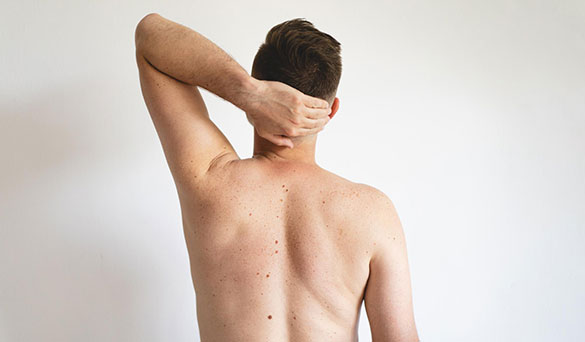
Where Do Sun Spots Appear?
Sun spots on skin can appear on different areas frequently exposed to the sun, such as the face, neck, hands, arms, and shoulders. Sun spots on the face are most common, as the area is most exposed to the sun; however, they can also appear visible in other areas. They are typically larger (half an inch or 13 millimetres across), so it can be easy to identify them when seeking treatment. However, it’s essential to consult a skin specialist to ensure you’re receiving the right treatment when removing sun spots.
How to Remove Sun Spots?
It can be challenging to get rid of sun spots without proper treatment. The treatment suitable for your skin depends on the degree of the condition, your budget, and the provider’s suggestions. When you want to figure out how to treat sun spots, the first step is to explore the different options available to you.
IPL Photofacial
When you want to remove sun spots on the face, hands, or neck, an IPL Photofacial might be one of the most effective solutions. You can visit GraceMed’s North York, Oakville, Mississauga, or Burlington locations to use IPL for sun spots.
IPL Photofacial is a safe treatment that targets pigment issues, such as sun spots with a bright light. The light passes through the epidermis, draws out the pigment-producing cells, and disperses the uneven pigment. GraceMed uses specialized handpieces that filter light from different parts of the spectrum, and our specialists can customize the treatment to help you effectively remove sun spots.
Chemical Peel
A chemical peel might do an impressive job when looking for the ideal sun spots on face treatment. A chemical peel can help you treat white spots on skin from sun. GraceMed offers chemical peels in several locations around the GTA, including Mississauga and King West Toronto clinics. One of the many benefits of a chemical peel is that it can minimize white sun spots and improve the overall texture of your skin, helping you look younger. Although chemical peels are most commonly used on the face, you can also use chemical peels to treat sun spots on hands.

A chemical peel removes sun spots by peeling away damaged skin, unclogs pores, speeds up the rate of cell turnover, and increases the skin’s brightness. During a chemical peel treatment, one of our specialists will apply an acidic solution, such as glycolic acid, trichloroacetic acid, or salicylic acid, to the skin. The solution removes the uppermost layer on the skin to reveal a fresh layer. The effect of the treatment may vary slightly depending on whether you want to treat sun spots on hands or face. However, a few types of chemical peels are available at GraceMed, allowing you to select one that best suits your aesthetic needs and overall skin.
HALO Profractional Laser
ProFractional Therapy is a quick procedure with minimal downtime that you can use to remove sun spots on the face and neck. Some people also treat white sun spots on the hands with this procedure. GraceMed offers HALO Profractional Laser treatment in several locations, including North York, Toronto, and Oakville.
The procedure can be custom-tailored to your specific skin conditions and desired outcomes, allowing you to treat your sun spots comfortably. One of the most incredible benefits of the HALO Profractional Laser treatment is that it only treats your desired area, leaving the surrounding skin untouched. This allows you to target sun spots on face and other areas quickly. Our specialists use a laser micro-beam, which creates many tiny, isolated channels in the skin. The handpiece will be moved around to all locations to ensure the entire treatment area has been covered.
Microneedling
Microneedling involves pricking the skin with tiny, sterilized needles to gently perforate the skin to generate new collagen and skin tissue for a smoother texture, firmer, and even-toned skin. This procedure can be effective at removing sun spots on face as it will naturally trigger collagen elastin synthesis within the skin with maximum results. If one session doesn’t remove your sun spots, you can repeat the treatment after discussing it with one of our specialists.
If you’re looking for clinics offering microneedling in Mississauga, visit one of GraceMed’s clinics nearby. Our specialists offer this service in four convenient locations around the GTA. We offer a customized treatment plan to address your needs and help you achieve your desired aesthetic goals. The plan will include a recommended number of sessions, session frequency, and maintenance treatments.
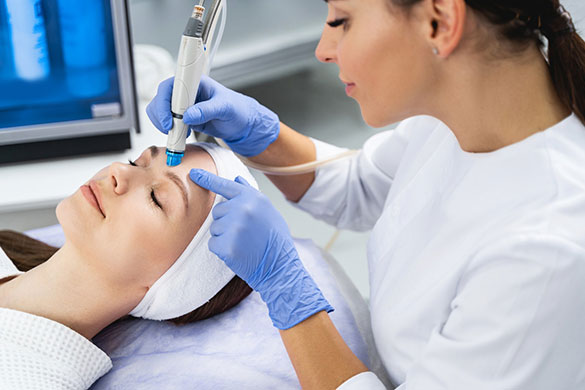
How to Prevent Sun Spots
Cosmetic treatments can only treat the desired area but cannot stop sun damage spots from appearing on your skin. Once you’ve determined how to get rid of sun spots, it’s important to learn how to prevent them from appearing again.
Use Broad-Spectrum Sunscreen
One of the best ways to prevent sun damage spots from appearing on your skin and hindering your confidence is by wearing a broad-spectrum sunscreen whenever you go under the sun. A broad-spectrum sunscreen protects your skin from harmful UVA (ultraviolet A radiation) and UVB (ultraviolet B radiation) rays. The combination of UVA and UVB rays can be dangerous for your skin and lead to sun spots on lips and other parts of your face and body.
When looking for the best sunscreen to protect your skin from sun spots and other sun damage, look for a product with SPF 30 or higher and broad-spectrum protection. You need to research and educate yourself about what to look for in the ideal sunscreen when attempting to prevent sun spots.
A 2017 study found that broad-spectrum protection influenced purchasing decisions for only 39 percent of surveyed consumers. Many people aren’t aware of what broad-spectrum sunscreen is, creating gaps in their knowledge about sunscreen.
Wear Protective Gear
By wearing the right gear, you can protect several areas of your skin and prevent sun damage spots. When you plan on staying under intense sun rays for extended hours, try to wear a wide-brimmed hat to prevent sun spots on lips and other areas of your face. It’s also vital to protect your eyes, so you should wear sunglasses to stop the sunlight from affecting the skin around your eyes.
The clothes you wear can also act as a shield to protect you from the sun. According to a McGill University article, some clothes have an equivalent rating called UPF or “ultraviolet protection factor.” Many sun-protective clothes display a rating of UPF 50+, which means that less than one out of every 50 UV rays that hit the material will pass through to affect your skin. When your clothes protect your skin from the sun, sun spots are less likely to appear in those areas.

Invest in High-Quality Treatments
Removing sun spots on the face after facial summer damage can be challenging if you don’t invest in the right treatments. You must do some research and choose effective treatments that can safely treat sun spots. Avoid DIY treatments that involve harsh chemicals, which can trigger the damaged area and lead to more skin problems.
To ensure that you choose the proper treatment, speak to a specialist at one of our GraceMed clinics. They can help you determine which procedure can help you achieve your cosmetic goals based on your skin type, treatment area, and budget.
Avoid the Sun at Specific Times
Try to schedule your plans based on the strength of the sun’s rays. The Canada Safety Council recommends scheduling outdoor physical activities before 11 am and after 4 pm, when the sun’s rays are the weakest, especially between April and October. This means you should avoid the sun between 11 am and 4 pm to prevent your skin from getting affected by sun spots.
Limit Tanning Bed Use
The UV rays from tanning beds accelerate melanin production, a pigment responsible for your skin colour. Extended exposure to tanning beds can cause the melanin to clump together or produce higher concentrations, resulting in sun spots. Tanning bed UV rays can also cause sun spots on lips and other areas of your skin.
Tanning beds can be just as harmful to the skin as the sun. Try to limit your tanning bed use to prevent sun spots from appearing due to the UV rays.
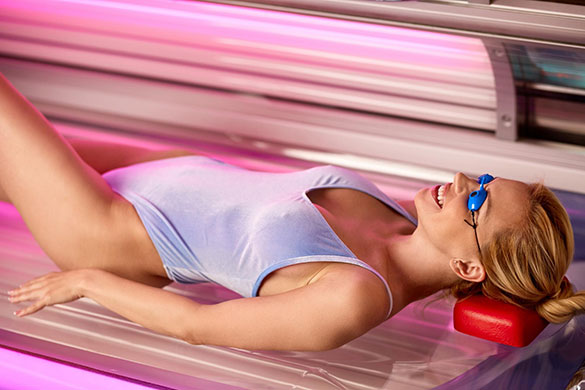
Prioritize Follow-up Treatments
Once you’ve learned how to get rid of sun spots and choose the right treatments, it’s important not to neglect follow-up care. If your provider recommends a follow-up treatment, it’s important to prioritize the treatment to maximize your results. One session isn’t enough to completely remove sun spots in some cases.
Treatments only reduce the appearance of sun spots or remove them after they appear, and they are not a preventative method. If you want to prevent sun spots, be cautious of how much time you spend under the sun and make sure to use sunscreen and wear protective gear. In addition, prioritize follow-up treatments and make your appointment before the sun spots become more prevalent once they appear.
Choosing the Right Treatment
There is a wide range of sun spot treatments available today. Many of GraceMed’s clinics offer a variety of treatments to help you choose the one that best suits your skin, budget, and aesthetic goals. It’s essential for you to speak to a specialist before proceeding with treatment, as they can guide you on your journey to removing sun spots.





